Sales strategies
The Ultimate Guide to Sales Coaching In 2019

Chris Orlob
Content Author
Published on: April 9, 2019
Are you looking to get better at sales coaching, but you’re not sure how?
Then this is the most important thing you’ll read today.
Let me guess: no one trained you for sales coaching.
You’re “making it up as you go.”
You’re simply doing your best to pass on what YOU know about sales to your team.
BUT… that’s a dangerous sales coaching mistake.
There are specific coachingmethodsyou can usetoday.Don’t settle for “random acts of coaching.”
There are alsotonsof damaging mistakes to avoid (Hint: You MUST know these).
In this post, you’ll learn those sales coaching techniques. Step by step. And you’ll avoid the mistakes that will send your team into a “death spiral.”
You’ll also get a FREE sales coaching checklist (if you want to skip ahead, you can get that here):

Anyway…
If you apply what you learn here,you’ll (probably) never miss your number again.
I’ve seendozensof sales leaders use these sales coaching tips to make their teams successful.
They’re proven. They work.
Now…
Here’s the first thing to know about sales coaching…
You’ll see results after one sales cycle.
Just one.
Let’s say you have a 60 day sales cycle.
If you have ONE great sales coaching session with a rep,you’ll see RESULTS in 60 days.
How exciting is that?!
No need for this “coaching is a long-term play” non-sense.
Change happens in one sales cycle.
Got it?
Here’s the second thing to know:
Sales coaching has CHANGED in the last 10 years
If you coach like people did 10 years ago, you and your team willmiss your number.
And you’ll miss amassiveopportunity to skyrocket your career.
Sales coaching has shifted from a tacticalactivity, to astrategicactivity.
Here’s why…
Today’s salespeople expect MORE from their employers.
Much more.
That wasn’t the case a few years ago.
A few years ago, a sales rep expected nothing more than to make good money. All they wanted was a good territory and a motivating comp plan.
But the rise of millennials in sales has flipped that on its head.
Millennials are a different breed of salespeople.
They place higher demands on the companies they work for. Much higher than yesterday’s seller.
What does that mean for sales coaching?
Millennial salespeople EXPECT you to invest in their development.
Sales coaching is not a “nice to have” for them.
It’s part of what they expect from the job. It’s a must-have.
If you don’t do sales coaching, they’ll leave.
If all you provide is a territory and a comp plan, you will lose the talent war. All they have to do is reply to the latest LinkedIn message they received from a recruiter.
Here’s the SECOND way sales coaching has changed…
The shift from FIELD sales, to INSIDE sales means one thing:Data.
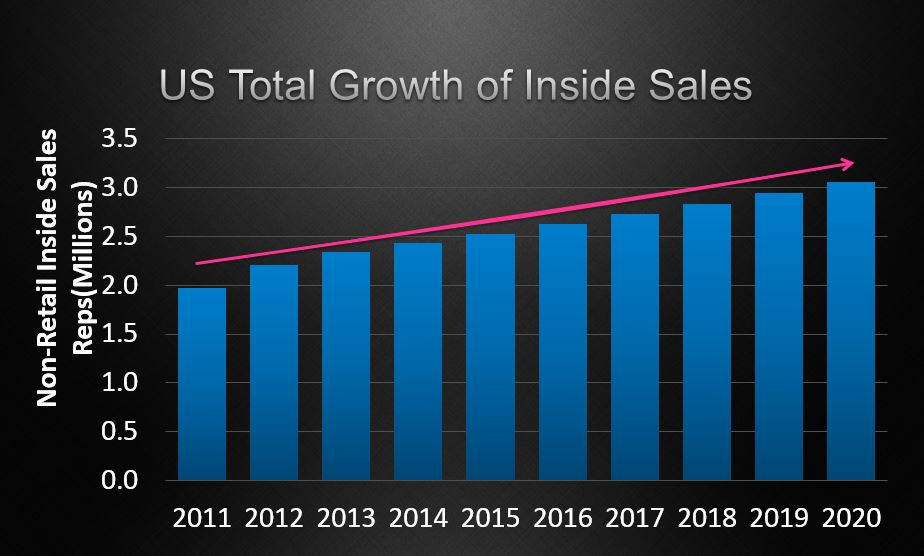
Instead of selling being face-to-face with NO data being captured, selling happensdigitally.
Reps make phone calls, send emails, and have web meetings.
All of those activities can beautomatically logged. That means, you guessed it,data.
Sales coaching today DEMANDS that you use this data to fuel your coaching efforts.
You can use conversion rate data to identify whatstageof your sales cycle your reps struggle with (more on that later).
And you can use sales CALL data to identify where reps need to improve during their customer conversations.
Here’s an example:
We learned (by analyzing 5 million sales call recordings) that if your “talk-to-listen” ratio on a sales call goes beyond 70%, you’remore likely to lose that deal.
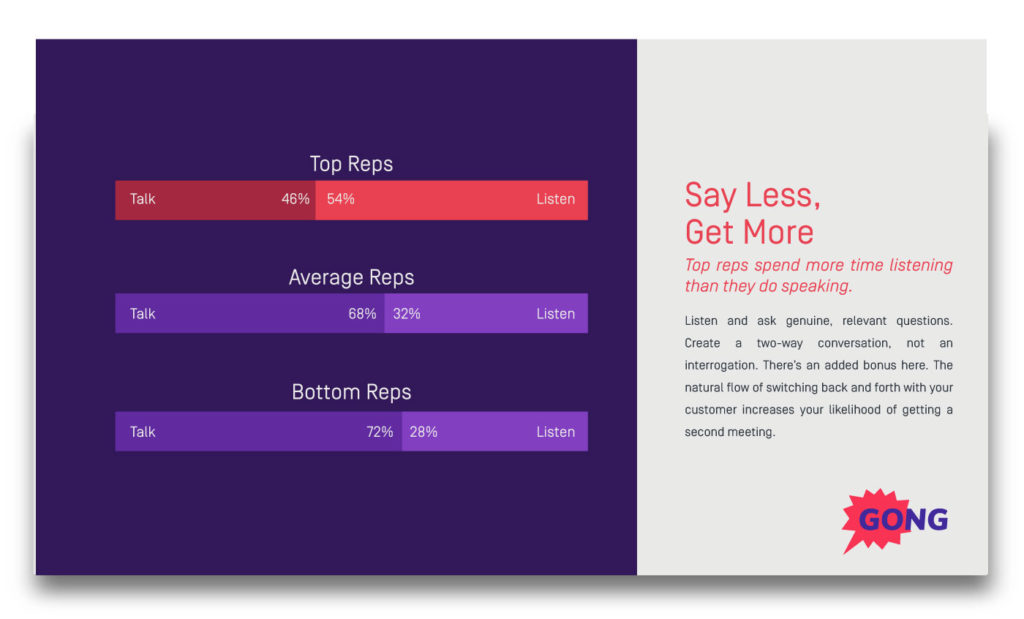
If you have data like this, you can INSTANTLY pinpoint where your reps need coaching.
Data is the sales coaching “secret weapon”
Now… before you learn sales coachingtactics, let’s talkstrategy.
Here’s the first thing you have to know about sales coaching STRATEGY:
Sales coaching only works with certain reps
It’s almost worthless when done with the wrongreps.
That’s your next mistake to avoid: Sales coaching on the wrong reps.
And guess what? MOST sales coaching targets the wrong reps!
Every sales team has three groups.
- High performers
- Middle-of-the-pack
- Low performers
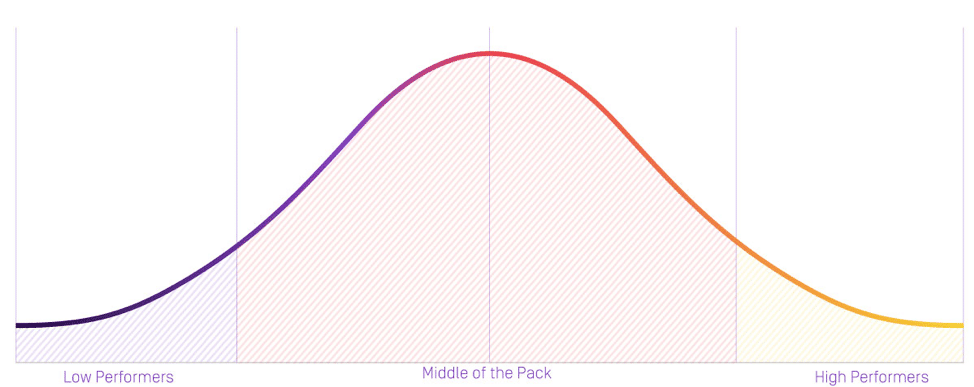
Your high performers are the top 20%. These reps CRUSH their quotas. 200% of goal.
Yourlow performersare thebottom20%.
They’re on the verge of losing their jobs. Professional selling is the wrong career for them.
And then there’s your middle-of-the-pack.
This is the group that falls somewhere in the middle. There are more of THEM than any other group. They usually make up ~60% of your team.
They’re doing okay. Around 80-90% of plan.
They’re your “B-Players.”
Sales coaching “payoffs” come from your B-Players
These are the reps that havelocked up potential.They’regood, but not yetgreat.
The right sales coaching can make them great.
The other two groups havelow returnson your time spent on sales coaching. Coaching them is “low impact.”
Your low performers are in the wrong job. They shouldn’t be in sales.
You can’t coach away a poor fit for a job.
Your time with them is better spent on helping them find a new career than it is on sales coaching.
Wait… What about your high performers?
Here’s the rub with your BEST reps: They are likepro golfers.
A pro golfer practices 10 hours a day to removea single strokefrom their 18-hole game.
They are already performing at the peak of their potential. There’s less room to grow.
Of course, you should still spend time developing them. You have to, to keep them.
But thebig returnsof sales coaching come from your middle-of-the-pack.
They have the two magic ingredients:
- Room to improve
- Potential to improve
Your high performers don’t have ROOM to improve.
Your low performers don’t have POTENTIAL to improve.
If you ignore this, you’ll spend the lion’s of your sales coaching time on the wrong people: Your best reps, and your worst reps.
WHO you coach is more important than HOW you coach.
There’s one more level of “who” to coach you need to understand…
Every rep on your team will fall into one of these four groups:

Youhaveto know which group each rep falls into.
Otherwise, you’ll make coaching mistakes that couldruinthat rep’s potential for success.
Coaching for skill vs. will is DIFFERENT
Here’s an example…
When I was a sales rep, I had a few (painfully) bad quarters in a row.
But skill wasn’t my problem. I knew how to SELL. Arguably better than anyone else on the team.
Instead, my sales manager was smart enough to see that something was “off” with my motivation.
After a long conversation, the truth came out. I wasdesperateto start my own company.
My sales job felt like an obstacle in the way of that dream. I felt like a pawn.
So what did my manager do? He changed the way I thought about my sales career:
- Sales experience iscriticalin building a successful career as an entrepreneur.
- I needed CASH to fund my future business
My sales job turned out to be agreatplatform for getting both of those.
He renewed my vigor. My grit was back. I went on to overachieve quota by a landslide.
BUT… what if he addressed the wrong thing?
What if my manager thought I had a skill problem? I would have continued to lose, and would have ended up quitting (or getting fired…)
Different problems. Different coaching approaches.
So let’s talk about each of these four groups for a minute.
Your BEST reps are “high skill, high will.”
They’ve got the selling chops. And, they aremotivatedto build a successful sales career.
Every now and then, you’ll run into someone with high skill, but low will.
Just like I touched on in my story, you’ve got to figure out their problem:
- Are they in the wrong career?
- Or have they lost touch with their “why”?
You’ve already learned about the “low will, low skill” group.
Your time is best spent helping these people find a better-suited career.
Sales management is hard enough.Trying to fixbothskill and will problems in one individual is like trying to swim with an anchor tied to your foot.
Coaching the “high will, low skill” reps works the best
They are your best group for sales coaching.
The best sales coaching is when you help people with a strong will increase their SKILL.
Your approach with this group is the opposite of the “high skill, low will” group.
Your sales coaching with these reps will target improving selling skills.
Not unlocking motivation.
Again, those are different tasks.
Think of sales coaching as a “funnel”
Alrighty. Let’s get into the “how” of sales coaching. Shall we?
The sales coaching process is a funnel.
You’ll START any sales coaching process by finding opportunities.
Where do your reps need to improve?
Then, you’ll address those areas of improvement. That’s the next stage in your “coaching funnel.”
And finally, you’ll follow through to make sure your reps take action.
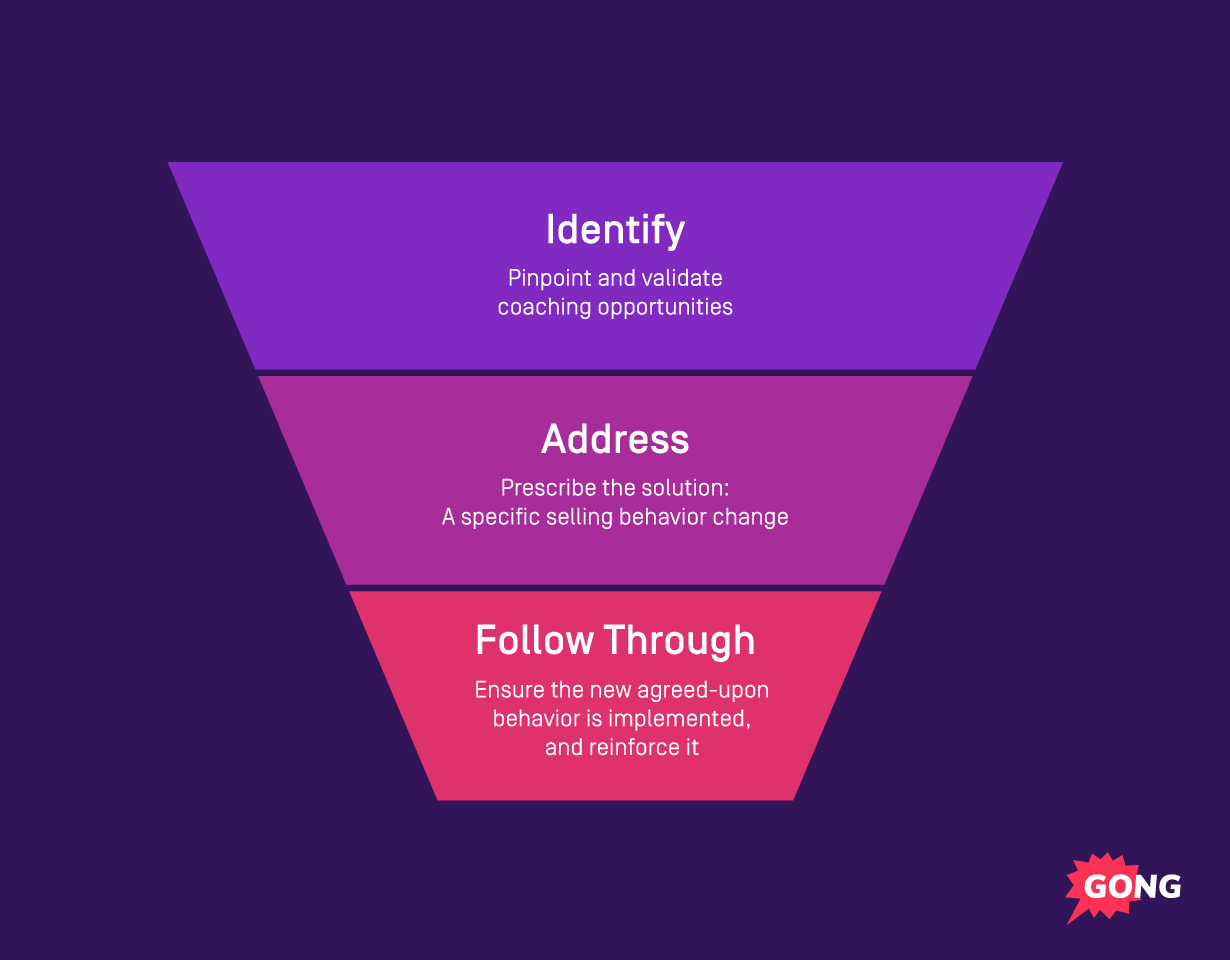
I use the funnel metaphor for a reason:Things usually “leak” through each phase.
For example, at the top of the funnel, you’ll likely find several coaching opportunities for a rep.
Let’s say you find five.
When you get to the next phase (address), you’ll overwhelm your rep if you try to tackle all five issues at once.
So you’ll focus on two or three key areas. The other 2-3 things will “leak.” They’ll fall by the wayside.
You’ll let them stay on the backburner for now.
Finally, most reps won’t act on everything you suggest.
They’ll get a few things right, and backslide on the others.
Completing a full sales coaching “cycle” might mean only a SINGLE behavior change.
Need inspiration? Download this sales coaching template to instantly find at least3 high-leverage areas to focus your coaching.
“STEP ONE” in the sales coaching process…
Is identifying sales coaching opportunities.
Start your sales coaching process by pinpointing areas of sales coaching opportunity.
If you know what your reps do on their sales calls, you’ll find a few areas of improvement:
- Fumbling through objections
- Generic discovery questions
- Feature-focused product demos
When you find these, ask yourself:Which one is the “highest impact” area to improve?
What will have the greatest returns?
Now… the first way to FIND these areas of improvement is to…
Use conversion rates as your “coaching compass”
Where does each rep have a bottleneck in the sales process? Where is their personal funnel “leaky”?
Which stage do their deals tend to drop off?
These metrics will show you what your reps struggle with.
You might find that some reps ROCK at converting product demos into free trials.
But the conversion rate of free trials into a commercial discussion is LOW.
Once you know that, now you’ve got to answer the million dollar question…
WHY is that stage’s conversion rate low?
You’ve got to get inside the conversations your reps have in that stage to answer it.
Here’s a hot tip for figuring out what’s going on.
Don’t shadow calls. Don’t do “ride-alongs.” Use call recordings, and meeting recordings.
Tools like Gong.io are great for that (but not required).
Call recordings are the ultimate sales coaching tool.
Call shadowing is a roll of the dice. And it doesn’t scale.
It’s tough to coordinate. Schedules are busy. You’re lucky to shadow a HANDFUL of calls per month.
When you use sales call recordings, you can coach on your own time.
And you can do WAY more sales coaching, in less time:
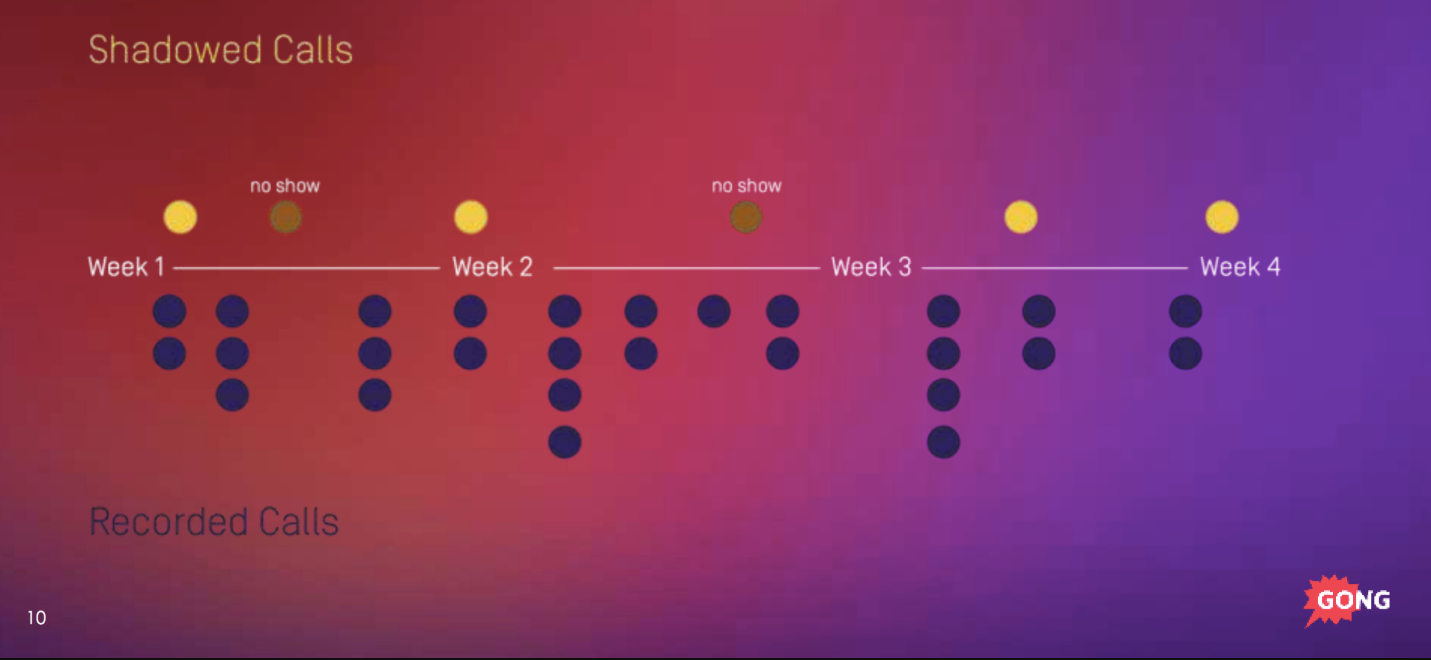
Now… the ability to FIND the right calls is massively important.
Otherwise, you’ll waste a ton of time sorting through recordings!
You’re a sales leader. You’re busy. Your time is valuable.
Soon, I’ll show you how to find good call recordings, FAST…
But I digress.
By now, you should have a WEALTH of knowledge about each rep.
You know where their conversion rates are low at certain stages in your sales process.
And you know WHY.
Now it’s time to get cracking on fixing that area.
Here’s what NOT to do (major sales coaching mistake…)
Once you figure out what’s wrong, don’t jump the gun. Hold back on giving them your advice.
Don’t (yet) them exactly what’s wrong, and what to do.
No, no, no.
You want your rep toownit. If you shove your coaching down their throat out of the gate, they’ll resist.
So, here’s what to do instead.
Make your reps do “self-reflection.”
Have them coach and critique themselves. BEFORE you give them a single piece of advice.
Here’s why…
They’ll come to their own “self-discovery” about what they need to improve (and HOW to improve it).
When they do that, they’ll OWN it.
They’re 10x more likely to fix the issue.
Call recordings are a powerful sales coaching tool
Ask your reps to self-review one of their calls using sales coaching software .
Have them take notes.
Have them write what they did well.
Have them write what they didn’t do well.
Like this:

Tell them you’ll do the same.
Tell them you’ll compare notes during your one-on-one.
Always start with self-coaching. Start with self-reflection.
But once you do that, here’s the next step…
Show your rep what “GOOD” looks like
Let’s go back to the above example.
Your reps struggles with converting free trials into commercial discussions.
WHY?
You listened to a bunch of calls in that stage.
And you found the problem: Your rep doesn’t get the customer’s buy-in on the project plan.
Instead of getting the buyer to “own” the next steps, your rep TELLS your buyer about your process.
As a result, the buyer doesn’t “own” the project. And they flake.
So here’s what to do next: show your reps what a GOOD use of a project plan looks like.
The best way to do that is to…
Show your rep an EXAMPLE of real sales call
Show ‘em one thatexemplifiesthe skill you’re trying to teach.
It’s worth building a library of call recordings that cover most of your selling scenarios.
These become a sales coaching GOLDMINE to draw from:
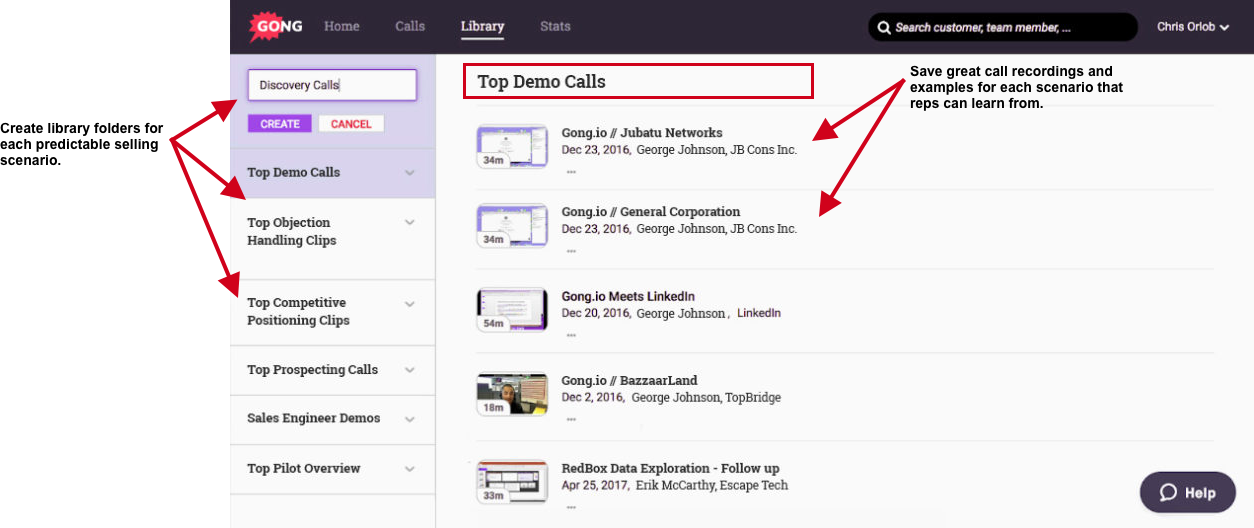
Play that call for the reps. Review it together. Have a conversation about it.
Let your rep pick it apart.
Let them come to theirownconclusions.
But don’t forget this CRITICAL sales coaching step…
Explain WHY that call is a “good” call.
You have to SELL your rep on adopting the new behavior. It’s your only hope for permanent change.
If all you do is tell themwhatto do, they won’t have the “staying power” to do it in a live sales call.
They’ll backslide.
Sell them on WHY this new behavior works. WHY it will help them become more successful.
DON’T SKIP THIS.
If you do…
Your reps will BACKSLIDE
They’ll go back to what they were doing before. You’ll waste all that sales coaching time.
And you know what? (Warning, you might not want to hear this):
Even if you DO explain “why” you want your reps to do something,many of them will still backslide.
Adopting new behaviors ishard.
You have to fight against old habits.
Asking new questions…
Overcoming objections in a new way…
Selling value instead of features…
It’s HARD to get that stuff under control. It’s hard to change the way you do it.
So, how do you make sure your reps ADOPT new behavior?
It goes back to the old Peter Drucker quote.
“What you measure, improves.”
Think about it.
If ALL you do is identify a coaching need…
And address it…
And tell your rep WHY they should do what you’re telling them…
And then you send them off into the wild…
UNMONITORED…
They won’t change. They’ll “keep doing what they’ve been doing.”
But what if you SCORED their calls againstkeycriteria? What if youmeasuredtheir calls?
What if call review was part of your job description?
What if you listened to calls, and GRADED your reps:
- Did you set an upfront contract?
- How well did you build rapport?
- How well did you tie value back to the customer’s pain?
- Did you secure next steps? How meaningful were they?
If you make call scoring like this a habit…
You’ll transform your “B-Players” into “A-Players”
In fact, if you do call scoring a few hours a week for six months,you’ll wake up to a completely different life.
You won’t even recognize your team.
Their skills will be completely different from what they are today.
It’s true.
Fortune really is in the follow-up.
Just not in the way you’re used to.
Are YOU following up with your REPS after coaching sessions by doing call scoring?
You can’tjusthold one-on-ones and expect things to suddenly work.
But if you have a sales coaching process (that includes follow-up),you can see your team’s quota attainment grow like never before.
If you want that to happen…
Here’s some great news for your sales coaching…
I’ve created a super effective call review CHECKLIST.
You can start using it today for FREE.
No strings attached.
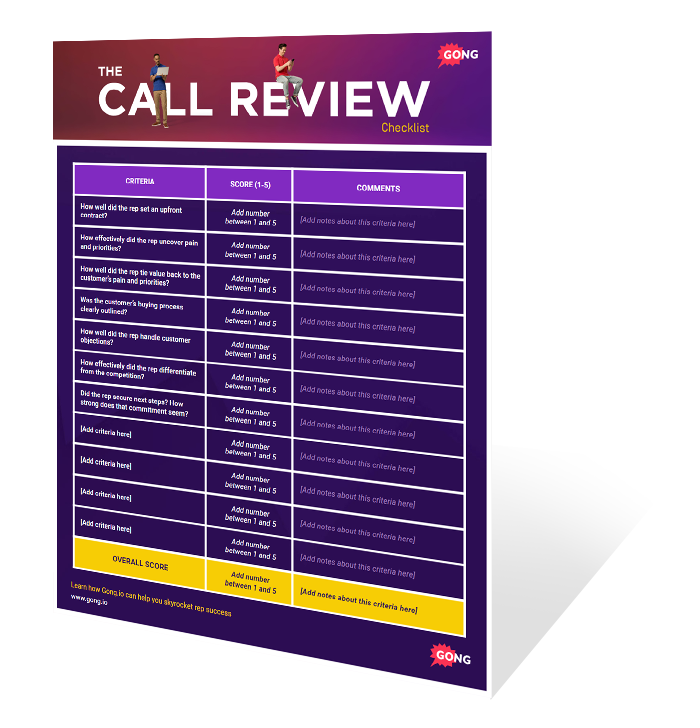
If that sounds interesting to you…
Here’s what to do next:
Download your free call review checklist here.

This simple little checklist can have a big impact on your career.
Over 10,000 sales managers (in the U.S.) have already downloaded this as of this writing.
I get DOZENS of emails from them every month telling me the same thing: IT WORKS.
Make sure you join them. Download your copy here.
Now…
Assuming you’re okay with my “hidden agenda,” you’ll want to keep reading to the next step.
That checklist will help you make your team MUCH more successful.
But… here’s the “catch” you’ve been waiting for
If you’re wondering if this is some sort of “bait and switch,” that’s understandable.
The good news? It’s not.
In fact, it’s the opposite.
If you’ve read this far, everything I’m about to tell you is in YOUR best interest.
Not mine.
Sure, using that call review checklist will help you.
But, I’m guessing youcringewhen you think of what you have to do to use it:
- You have to make sure your reps record their calls…
- You have to FIND the right calls to score (among hundreds)…
- You have to slog through asloowwwwcall recording at 1x speed. Just to find out it was thewrongcall to listen to.
The whole “call review” process is broken. It’s so inefficient. That’s why no one does it!
So, here’s my offer to you.
I’ll make your call review 10x more efficient…
… 10x more effective…
… And you’ll do it all in a THIRD of the time.
How’s that for a value prop?
You can make that happen by trying out Gong . It’s your ultimate call coaching POWER TOOL:
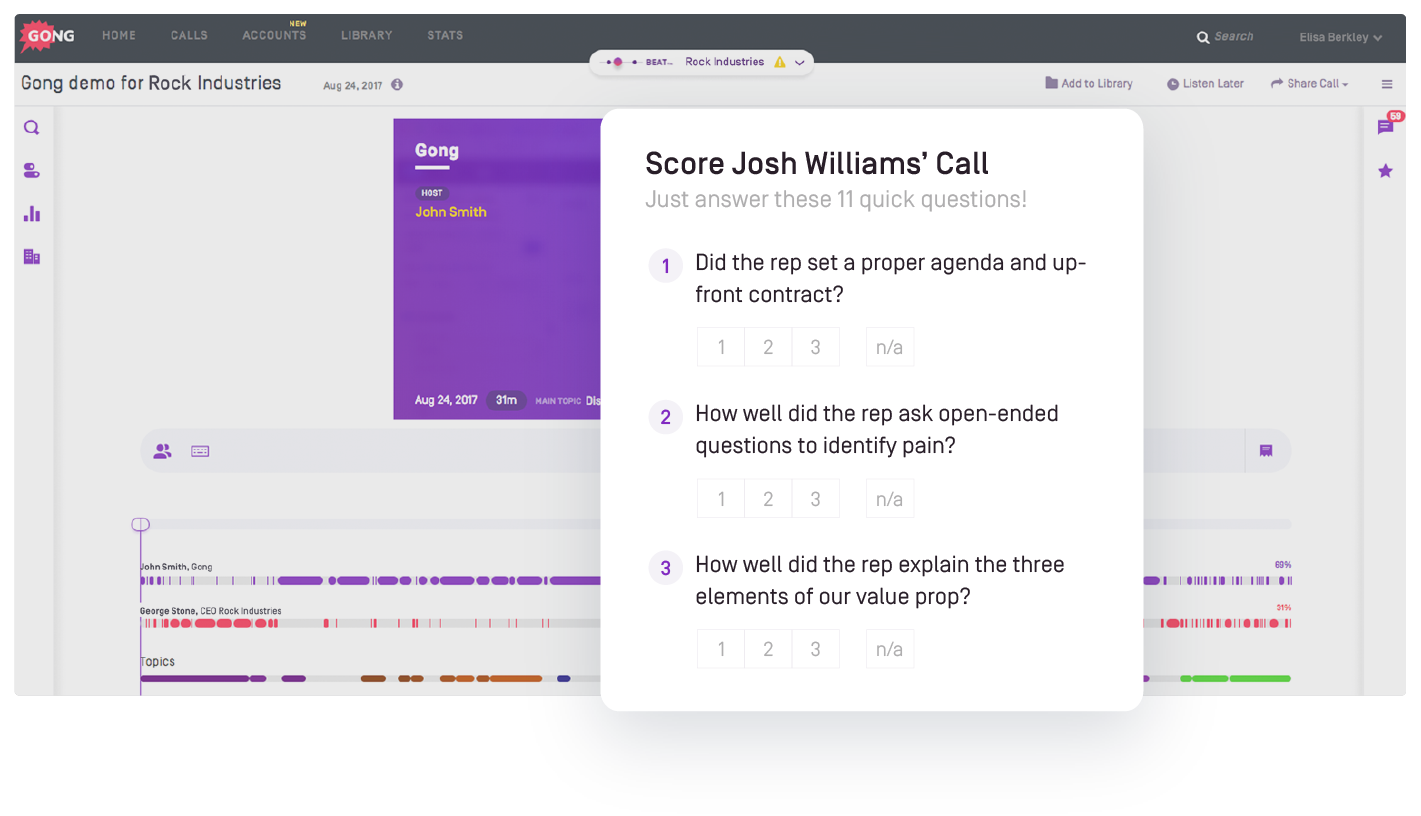
You can transform your B-Players into A-Players with great call review.
All in less time. And, it’s FUN (Heaven forbid…).
Here’s what sales managers just like YOU are saying about it:

So…
If you’re serious about better sales coaching…
If you’re serious about making your reps more successful….
Sign-up to take Gong.io for a “test run.”
Join the tribe of thousands of successful sales managers using it.
Many of them have gone on to get promoted.
VP Sales. SVP Sales. CRO.
And forget everything I say. Try it yourself for free:

Thanks for reading this!
P.S.
If you’re one of those people (like me) who skim down to the P.S. before you read, here’s what this is all about:
ONE:A cool way to do sales coaching that makes your reps better.
TWO: A helpful sales coaching checklist you can use for free.
THREE: A useful sales coaching platform to tie it all together.

Content Author
Chris Orlob is the Co-Founder and CEO of Pclub.io, a leading sales training platform designed to help sales professionals accelerate their revenue growth. He is best known for his pivotal role at Gong, where he helped scale the company from $200,000 to $200 million in ARR, contributing to a $7.2 billion valuation. During his tenure at Gong, Chris led the creation of Gong Labs and excelled in various go-to-market roles. Today, through Pclub.io, he leverages his deep expertise in sales and revenue operations to coach over 11,000 SaaS sellers.
Discover more from Gong
Check out the latest product information, executive insights, and selling tips and tricks, all on the Gong blog.



